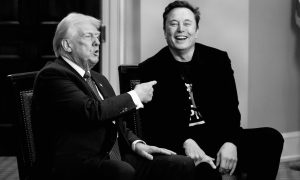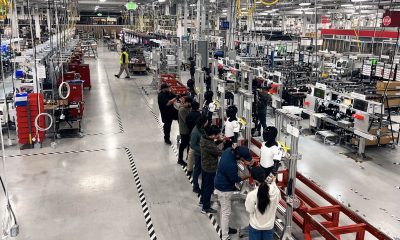News
Rivian startup spinoff raises $105M in funding for micro EV production
Meet Also, Rivian’s micro EV spinoff, now a full-fledged startup with $105M in funding. It’s adapting Rivian’s tech for compact EVs.

Rivian’s skunkworks program has turned into a full-blown startup called Also. The new startup, which is separate from Rivian, raised $105 million from Eclipse Ventures. Also will focus on micromobility or the development of micro electric vehicles.
Also started within Rivian, aiming to figure out if the electric vehicle company’s technology could be condensed to fit smaller EVs, including vans, trucks, and SUVs. Eventually, the skunkworks program discovered it could, indeed, fit Rivian’s technology in smaller, more compact electric vehicles, but the project was bigger than Rivian.
“We’ve been taking the Rivian technology stack and adapting it to much smaller form factors and then coming up with some incredibly exciting embodiments of that technology in these very small form factors,” Rivian CEO RJ Scaringe told Reuters.
Rivian will always be part of Also. It holds a minority stake in Also and Rivian’s VP of future programs, Chris Yu, will be the startup’s president.
According to Scaringe, Also plans to debut its first vehicle designs later this year. One of the designs seems to be a bike, as Scringe described it having a seat, two wheels, and a screen with a few computers and a battery.
Also aims to start producing its flagship product by 2026 for customers in the United States and Europe. In addition, it plans to launch consumer and commercial vehicles made for Asia and South America.
News
Tesla Full Self-Driving displays impressive collision avoidance with semi
A Tesla on Full Self-Driving helped a driver avoid a collision with a semi by anticipating the truck’s movement.

Tesla Full Self-Driving has displayed incredible anticipatory measures in the past to avoid collisions from both oncoming cars and vehicles approaching from behind.
In a recent demonstration, the semi-autonomous driving functionality averted disaster as it confused the driver by taking a precautionary measure as an oncoming semi-truck started to drift into its lane. By the end of the occurrence, the driver knew why FSD did what it had done.
Tesla’s FSD Supervised prevented this family from hitting a deer
Full Self-Driving avoids disaster
In a video from X account @AIDRIVR, Full Self-Driving navigated as normal when it started to take an oncoming sharp left-hand curve a tad higher than usual.
Normally, the vehicle would stay in the lane, but this time, it started to drift toward the shoulder after what appeared to be a small reduction in speed.
AIDRIVR said he “wondered why FSD was taking this corner so wide,” but the answer quickly approached him from the other side of the road, proving once again that Tesla’s suite is a few steps ahead of even human drivers at times:
wondered why FSD was taking this corner so wide when suddenly… pic.twitter.com/zoIP5tXCm9
— ΛI DRIVR (@AIDRIVR) May 13, 2025
A semi-truck in the oncoming lane started to drift over the center line through this sharp turn.
With these large vehicles, these curves can sometimes prove to be better handled by taking the turn a tad wider, which means the large commercial vehicle will start to approach the middle yellow lines.
However, this is much to the chagrin of other drivers and can be a major inconvenience and safety hazard.
Full Self-Driving continues to show instances where it is predicting and anticipating the behaviors and actions of other drivers, keeping occupants in the Tesla safe by using certain tactics to avoid collisions.
Elon Musk
Tesla CEO Elon Musk confirms Robotaxi will come to Saudi Arabia
Tesla Robotaxi will be in Saudi Arabia one day, Elon Musk confirms.

Tesla CEO Elon Musk confirmed during the Saudi-U.S. Investment Forum on Tuesday that the company’s Robotaxi platform would eventually land in the Kingdom of Saudi Arabia, essentially confirming the intention to grow a driverless fleet of vehicles outside of the United States.
This is the first time Musk has specifically confirmed Tesla’s intention to expand into Saudi Arabia, although based on the company’s plans, a global expansion is more expected than a confined Robotaxi platform that is limited to only the West.
Musk confirmed during the Investment Forum, where the U.S. agreed with the Saudis to a $600 billion investment pledge, that Robotaxi would eventually expand to the country. The CEO did not mention a specific timeframe, but Tesla is set to launch the Robotaxi platform in Austin, Texas, in June.
“Really, you can think of cars, or future cars, as being robots on four wheels. I think it will be very exciting to have autonomous vehicles here in the Kingdom, if you’re amenable.”
🚨 Tesla Robotaxi will be available in Saudi Arabia, Elon Musk confirms:
“You heard it here from Elon! He’s bringing Robotaxi to the Kingdom.” pic.twitter.com/3IeaZezYb8
— TESLARATI (@Teslarati) May 13, 2025
As Tesla’s Full Self-Driving suite is still supervised, it is expanding to other parts of the globe. Earlier this year, it made its way to China for the first time ever, with many giving rave reviews of the driver assistance platform.
Tesla plans to expand to Europe later this year, but the company is still awaiting regulatory approval from EU agencies, something that will likely take some time to complete.
The big takeaway is that the Robotaxi platform is not confined to a single model, like the Cybercab. Instead, Robotaxi could be any Tesla vehicle, as long as it is capable of unsupervised Full Self-Driving. This is something that will require Tesla to work with local authorities to first launch a Supervised version of the suite, which could then expand to the unsupervised FSD platform, enabling a Robotaxi network in the country.
Nevertheless, Tesla’s relationship with the Middle East seems to be good. The company recently launched the Cybertruck in Saudi Arabia, enabling customer orders just last month.
Tesla confirms Cybertruck will make its way out of North America this year
Additionally, Musk’s Starlink was recently given approval for both maritime and aviation use cases, expanding the relationship between the country and the CEO. This was also confirmed during the Investment Forum today.
News
Tesla is building Cortex 2.0 supercomputer facility in Giga Texas
The site was listed as the Central Campus Support facility, but recently, the filings have been updated as Cortex 2.0.

Tesla may already have a supercomputer cluster in the Giga Texas complex, but it seems like the electric vehicle maker is not done with its supercomputer plans just yet. Based on images taken of the Giga Texas complex recently, it appears that work is now underway to construct a new facility for Cortex 2.0, a companion to the site’s existing Cortex supercluster.
New Giga Texas Facilities
As per longtime Tesla Gigafactory Texas watcher Joe Tegtmeyer, Tesla has been constructing a facility on the North side of the complex for a few months now. Initially, the site was listed as the Central Campus Support facility, but recently, the filings have been updated as Cortex 2.0. So far, work is underway for the Cortex 2.0 building shell, though permits have already been filed for other parts of the upcoming facility.
The speed of the buildout for the Cortex 2.0 facility is rapid, with the drone operator estimating that the location may be operational as early as late this year. It would also not be surprising if Tesla ends up ramping its activities at Gigafactory Texas’ Cortex 2.0 supercomputer cluster sometime next year.
FSD Training and Beyond
Tesla’s heavy investments in its supercomputer clusters are expected to help the company develop and refine its self-driving system, which is currently deployed in non-autonomous form as Full Self-Driving (FSD) Supervised. Tesla is expected to launch a robotaxi service in Austin in a few weeks, though these vehicles are expected to use FSD Unsupervised, which would be fully autonomous.
Apart from FSD, Tesla’s Optimus program will likely require a substantial amount of computing power as well. Elon Musk has stated that Tesla should be able to build its first “legion” of Optimus robots this year, with production ramping next year. Considering these ambitious timelines, perhaps Giga Texas’ Cortex 2.0 facility would be fully busy as soon as it becomes operational.
Check out a recent drone flyover of the Giga Texas complex in the video below.
-

 News1 week ago
News1 week agoTesla offers legacy Model Y owners an interesting promotion
-

 News5 days ago
News5 days agoTesla Cybertruck Range Extender gets canceled
-

 News2 weeks ago
News2 weeks agoLike it or not, the new Tesla Model Y is a big hit in China
-

 News2 weeks ago
News2 weeks agoTesla China vehicle registrations rise 51% in April’s fourth week
-

 Elon Musk2 weeks ago
Elon Musk2 weeks agoElon Musk is now a remote DOGE worker: White House Chief of Staff
-

 News2 weeks ago
News2 weeks agoNeuralink’s third brain chip patient shares first video edited with BCI
-

 News2 weeks ago
News2 weeks agoTesla hired over 1,000 factory workers for its Semi program in NV: report
-

 News2 weeks ago
News2 weeks agoRobots like Tesla Optimus are a $5 trillion opportunity: analyst



















